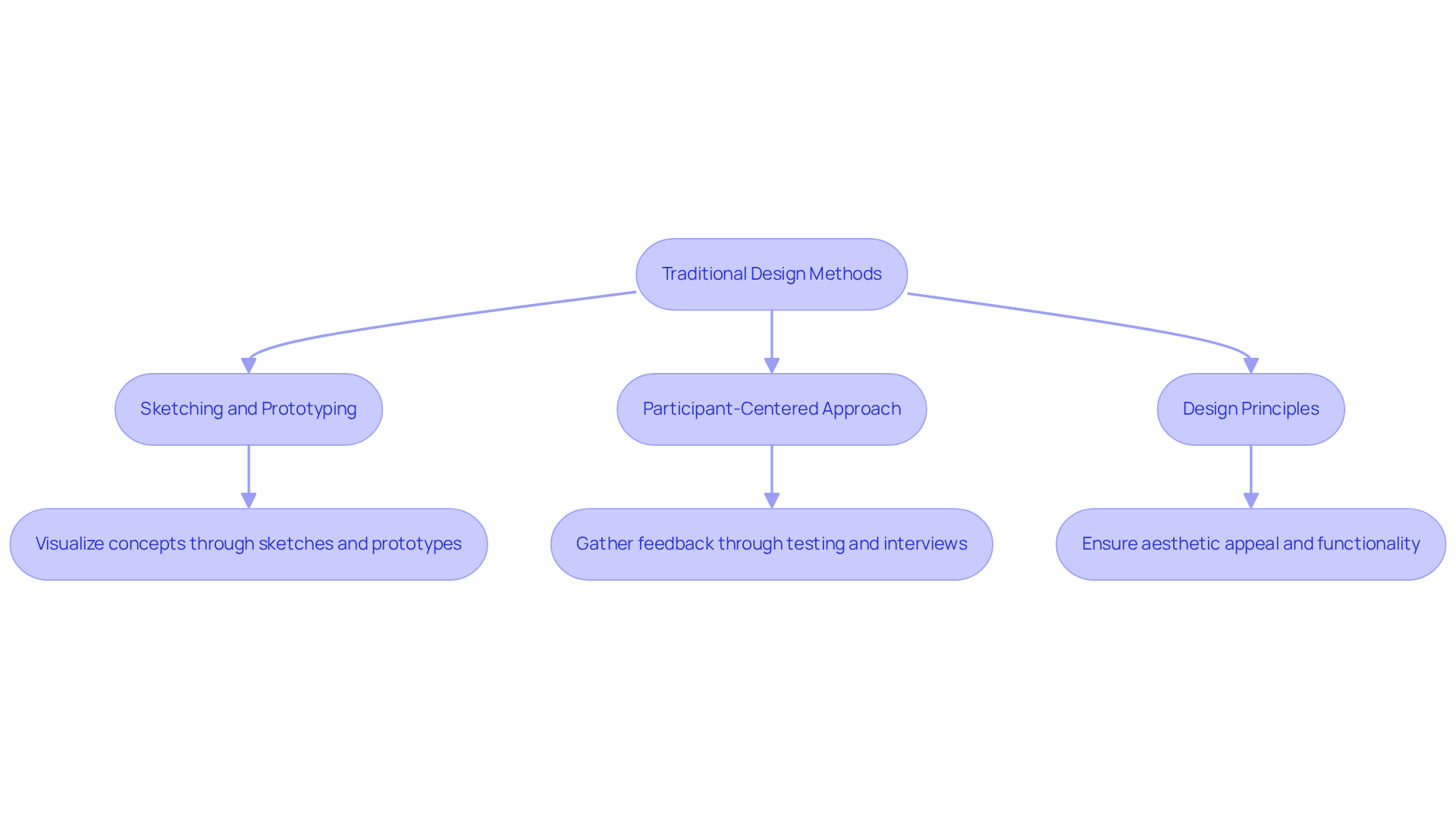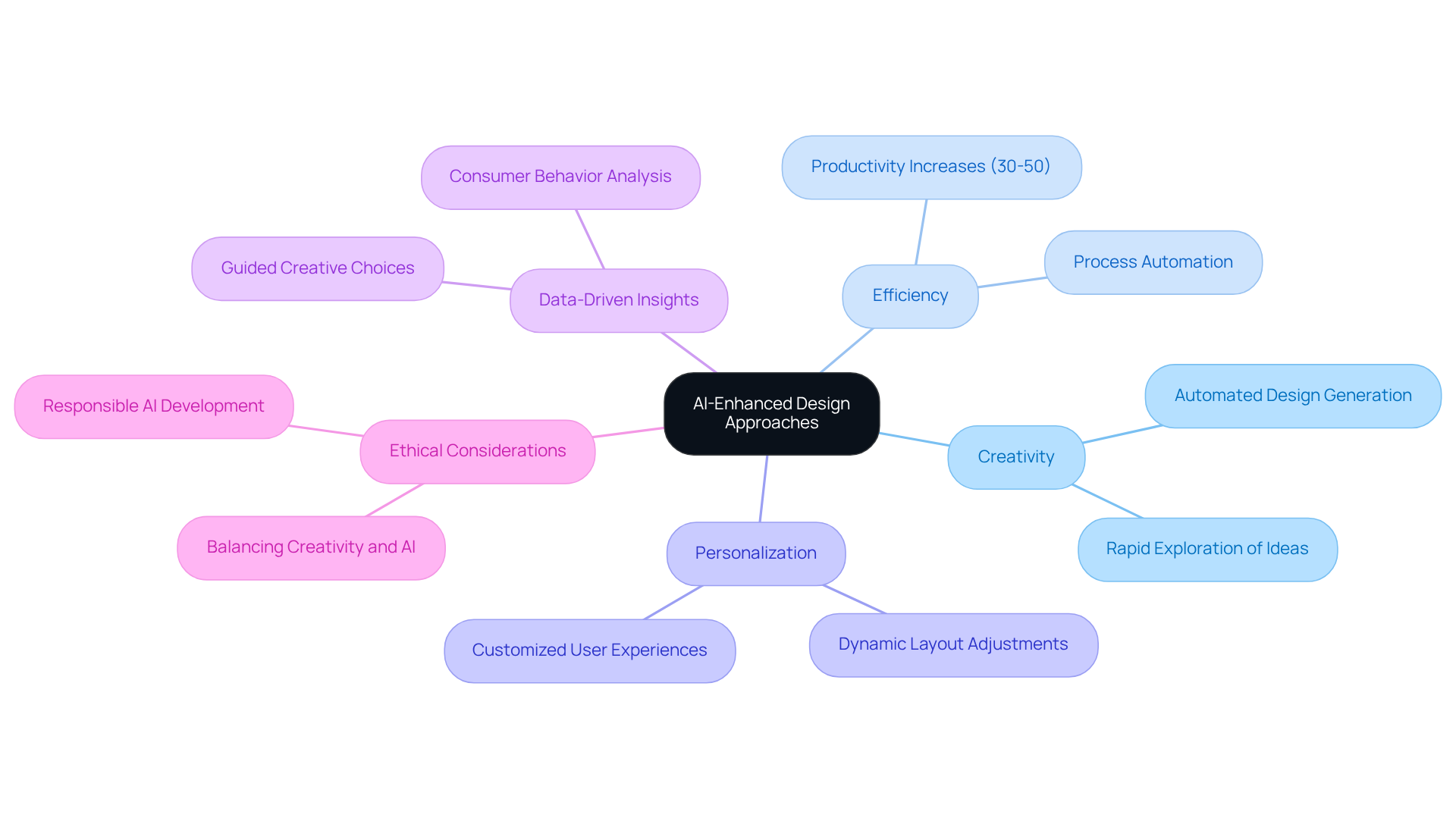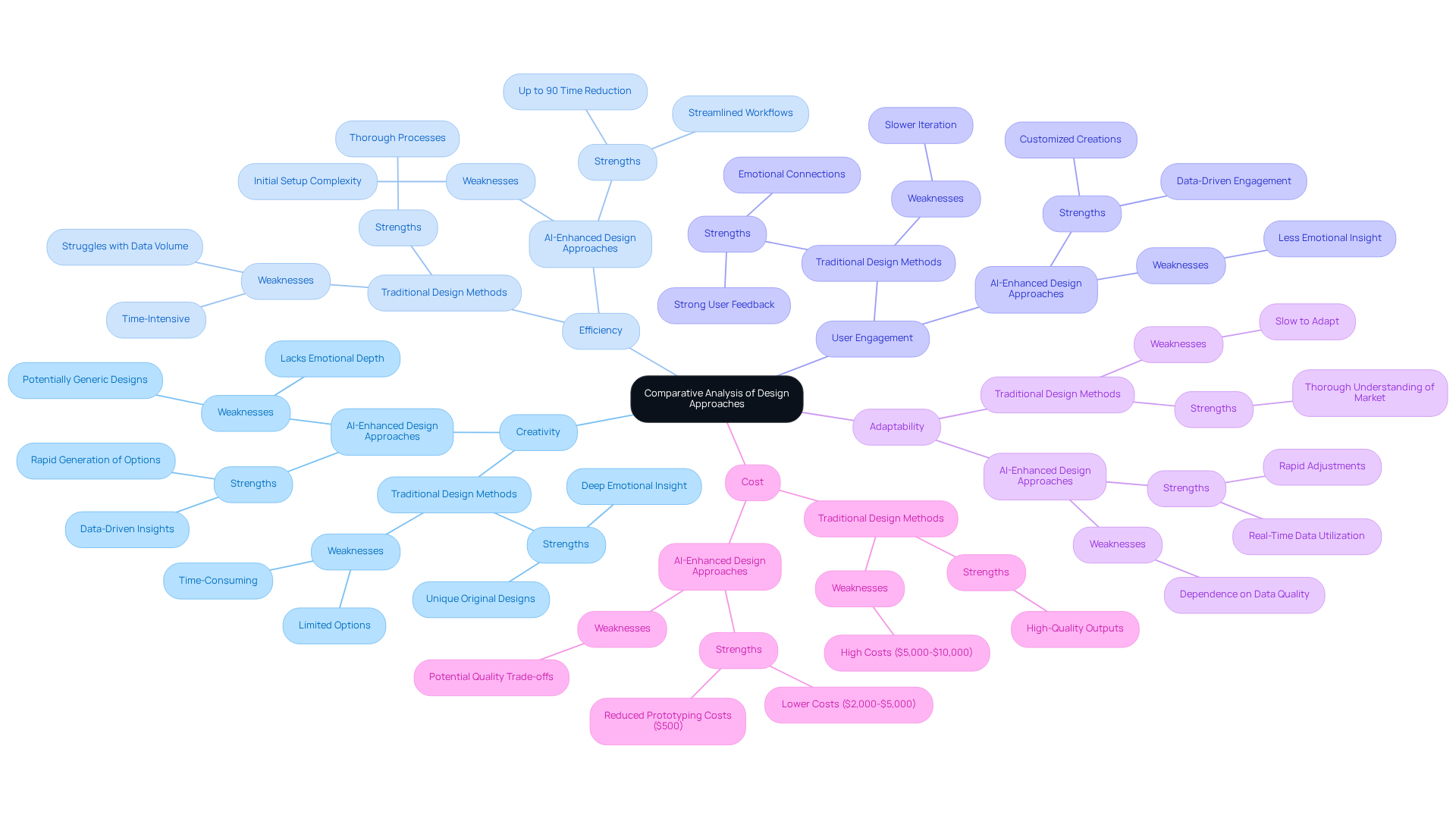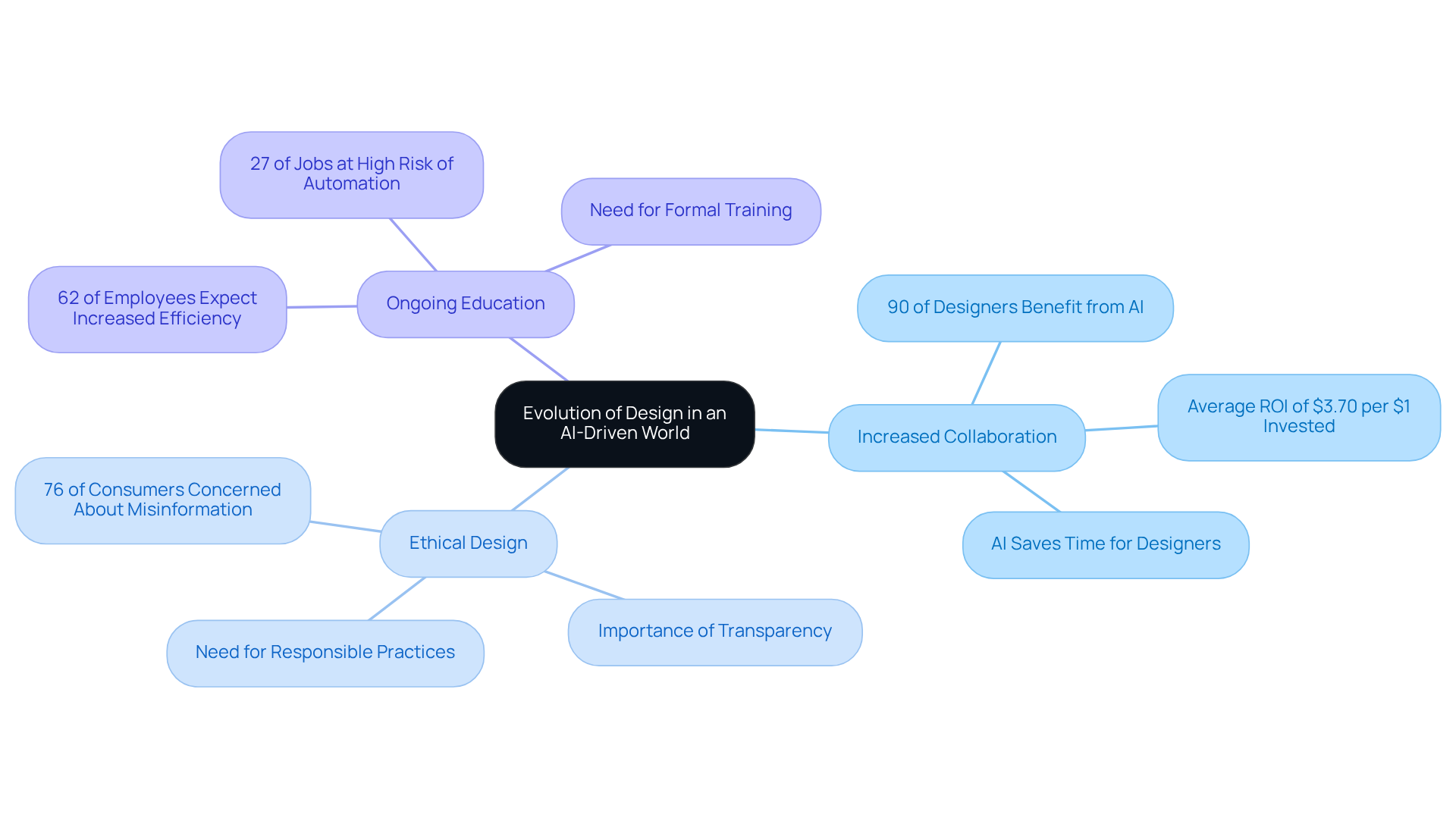Overview
In the fast-paced world of design, many professionals face a common challenge: traditional design methods can often be time-consuming and emotionally draining. This struggle not only affects productivity but can also stifle creativity, leaving designers feeling overwhelmed and disconnected from their work. It’s important to acknowledge this pain, as it resonates deeply with those who pour their hearts into their creations.
However, there is hope. AI-enhanced design approaches offer a transformative solution that not only streamlines workflows but also reignites the creative spark. By integrating AI into the design process, designers can alleviate the burden of repetitive tasks, allowing them to focus on what truly matters: strategic creativity. This shift not only enhances user engagement but also fosters a more fulfilling design experience.
Imagine a world where your time is spent on innovative ideas rather than mundane processes. With AI innovations, this vision becomes a reality, enabling designers to reclaim their passion and purpose. By embracing these advancements, you can transform your design journey into one that is not only efficient but also deeply rewarding. Let’s explore this path together, as we navigate the exciting possibilities that lie ahead.
Introduction
The design landscape is facing a significant challenge as traditional methods grapple with the demands of our rapidly changing world. While cherished practices celebrate human creativity and the importance of iterative feedback, they often find themselves lagging behind the swift advancements in technology and market expectations.
This article explores the fascinating contrast between conventional design techniques and the innovative potential of AI-enhanced approaches, inviting you to consider how these two realms might either conflict or work together harmoniously.
As designers navigate this evolving landscape, what opportunities lie ahead? How can the integration of AI not only streamline workflows but also enrich the creative journey?
Together, let’s delve into these questions and discover ways to embrace this transformation with optimism and support.
Understanding Traditional Design Methods
Traditional creation methods encompass a range of practices that have evolved over decades, focusing on manual processes, human creativity, and iterative feedback loops. However, these methods can often feel overwhelming and slow, especially when faced with the fast-paced demands of today’s market. This can lead to frustrations for those and client expectations.
Consider the initial steps of the process:
- : Designers create initial sketches and prototypes to visualize concepts, relying heavily on their artistic skills and intuition. This can be a deeply personal journey, yet it requires time and patience.
- : Highlighting feedback from individuals, conventional techniques include thorough testing and interviews to improve layouts based on actual interactions. While this approach values user input, it can also as adjustments are made.
- : Established principles such as balance, contrast, and hierarchy guide the creation process, ensuring aesthetic appeal and functionality. Yet, adhering strictly to these principles may sometimes stifle creativity and adaptability.
While these methods have shown to be effective, they can indeed be time-consuming and may not always adjust swiftly to shifting market demands. This results in possible delays in project timelines and responsiveness to client needs, leaving many feeling anxious and uncertain.
At RNO1, we understand these challenges deeply. We are here to support you in navigating these complexities, offering solutions that not only but also nurture your . Together, we can find a way to adapt and thrive in this ever-evolving landscape.

Exploring AI-Enhanced Design Approaches
In today's fast-paced world, many tech startup founders grapple with the challenge of balancing in their processes. This struggle can feel overwhelming, especially when the pressure to innovate is constant. The implications of this challenge are significant: without effective strategies, the creative spark can dim, leading to frustration and stagnation.
At RNO1, we understand this pain deeply. Our strategies, which integrate [AI and design](https://researchgate.net/publication/384953179_The_Impact_of_Artificial_Intelligence_on_Design_Enhancing_Creativity_and_Efficiency), are designed to alleviate these concerns, showcasing our commitment to innovation-driven solutions that truly resonate with your needs. Imagine a world where , allowing for rapid exploration of creative possibilities. With our , you can swiftly produce numerous design variations based on your inputs, significantly accelerating the ideation phase. This not only sets RNO1 apart from competitors but also empowers you to focus on what truly matters—your vision.
Moreover, our approach to AI and design is rooted in . By examining consumer behavior and preferences, our AI guides your creative choices, ensuring that the final product aligns with your audience's needs and expectations. This principle is at the heart of our , fostering a connection that is essential for success.
Personalization is another cornerstone of our offerings. Our AI enables the development of , dynamically adjusting layouts in real-time based on user interactions. This boosts engagement and satisfaction, highlighting RNO1's innovative creative solutions that nurture your goals.
These advancements not only foster creativity but also enhance efficiency, allowing designers to concentrate on strategic elements rather than repetitive tasks. The collaborative intelligence model we promote illustrates the synergy between creativity, AI, and design, demonstrating how AI can enhance outcomes without replacing personal input. Statistics reveal that organizations integrating AI into their product workflows have reported productivity increases of 30%-50%, underscoring the effectiveness of these technologies.
Particular applications, like AutoCAD and IBM Watson, demonstrate how AI tools can enhance development processes. However, it is crucial to contemplate the ethical consequences of AI in creation, ensuring that its incorporation aligns with societal values and creativity. At RNO1, we are here to support you on this journey, providing not just tools, but a partnership that understands and nurtures your aspirations.

Comparative Analysis: Pros and Cons of Each Approach
| Criteria | | | |------------------------------|-----------------------------------------------|---------------------------------------------| | Creativity | Traditional design methods lean heavily on human intuition and artistic skills, nurturing unique and original designs while offering profound human insights. These methods often resonate deeply, creating . | In contrast, AI can swiftly generate a multitude of creative options, though it may sometimes miss the emotional depth and insight that human designers provide. The collaborations within this organization, particularly with Figure, showcase how blending human-focused innovation with , fostering a harmonious balance between technology and artistry. | | Efficiency | The traditional approach can be quite time-consuming, often requiring weeks to complete projects. This method struggles to manage the volume and complexity of data in today’s digital landscape, leading to frustration. | However, AI-enhanced design approaches streamline workflows through automation, by up to 90%. illustrate how these methods can , evidenced by a remarkable 30% decrease in project turnaround times, alleviating some of the stress associated with lengthy processes. | | User Engagement | Traditional design places a strong emphasis on user feedback through iterative processes, which fosters emotional connections and deep human insights. This engagement is vital for creating meaningful experiences. | On the other hand, AI leverages data-driven insights to enable customized creations that enhance participant engagement based on behavioral analysis. While this approach may lack some of the emotional depth found in conventional methods, case studies from this organization highlight how the integration of AI and design with user input can lead to more captivating digital experiences, resulting in a 25% rise in , bringing joy to users and designers alike. | | Adaptability | Traditional methods tend to be slower in adapting to market changes, often requiring extensive revisions and facing challenges in scalability. This can leave founders feeling overwhelmed and behind. | Conversely, AI allows for rapid adjustments based on real-time data, enabling quicker responses to evolving trends. The organization’s collaboration with firms like Spring Labs emphasizes the in creation, utilizing AI and design to stay ahead of market needs, which leads to a 40% quicker reaction to changes. This adaptability can provide much-needed relief in fast-paced environments. | | Cost | The costs associated with traditional design can be daunting, often ranging from $5,000 to $10,000 due to extensive labor and time investments. This financial burden can weigh heavily on startup founders. | In contrast, AI-enhanced methods can significantly lower costs through automation, reducing expenses to between $2,000 and $5,000. Additionally, prototyping costs can drop from $2,000 to just $500. RNO1's collaborations illustrate how AI can help manage expenses while delivering high-quality solutions, . This financial relief can empower founders to focus on their vision and growth. |

Future Trends: The Evolution of Design in an AI-Driven World
As AI continues to evolve, we face a pivotal moment in the design world, where several trends are poised to redefine our future:
- Increased Collaboration: Designers are increasingly partnering with , merging human creativity with machine efficiency. This partnership is not just about technology; it’s a way to enhance our . Many designers, around 90%, have shared how , allowing them to focus on more intricate tasks that truly matter. Businesses are witnessing an impressive , underscoring the profound impact AI has on productivity across various sectors.
- Ethical Design: As AI's influence grows, we must turn our attention to . With 76% of consumers expressing , it’s crucial for designers to prioritize transparency and responsible practices. This commitment to ethical design helps maintain trust, which is essential in our relationships with users.
- Ongoing Education: AI systems are learning and evolving through interactions, leading to creations that progress over time. This dynamic approach is expected to significantly enhance client satisfaction and engagement. In fact, 62% of employees anticipate that . However, we must also acknowledge the concern that 27% of jobs are at high risk of automation due to AI, prompting in the creative field.
These trends signal a shift towards a more integrated design methodology, where individual creativity works together with AI and design capabilities to create exceptional . This transformation is not just about technology; it’s about how we can support one another in navigating these changes. As Sundar Pichai wisely noted, '.' Let’s embrace this journey together, fostering a future where creativity and technology coexist harmoniously.

Conclusion
The exploration of AI in design highlights a significant challenge: the shift from traditional methods to innovative, technology-driven approaches. Traditional design, while rich in human creativity and iterative feedback, often grapples with time constraints and the need for adaptability in a fast-paced market. This can leave designers feeling overwhelmed. However, AI-enhanced design presents a promising solution, streamlining workflows and fostering creative exploration. It empowers designers to concentrate on their vision while leveraging data-driven insights and personalized experiences.
As we delve deeper, it becomes evident that both approaches have their strengths and weaknesses. Traditional methods excel in nurturing emotional connections and providing deep insights, yet they can feel cumbersome and slow, which can be frustrating for designers. Conversely, AI tools offer remarkable efficiencies, significantly reducing project timelines and costs, and enhancing user engagement through customized experiences. The collaborative model between human designers and AI illustrates a hopeful path forward—a harmonious balance that amplifies creativity without sacrificing the personal touch.
As the design landscape continues to evolve, it’s crucial to embrace these advancements. The integration of AI not only enhances productivity but also opens new avenues for creativity and innovation. By prioritizing ethical considerations and ongoing education in AI design, we can cultivate trust and transparency, ensuring that technology serves to augment human capabilities. The journey toward a future where creativity and AI coexist harmoniously is not just an opportunity; it’s a necessity for thriving in an increasingly complex world. Together, let us navigate this transformative journey with compassion and understanding, ensuring that every step forward is a step toward a more innovative and supportive design community.
Frequently Asked Questions
What are traditional design methods?
Traditional design methods encompass a range of practices that have evolved over decades, focusing on manual processes, human creativity, and iterative feedback loops.
What are some initial steps in traditional design methods?
Initial steps include sketching and prototyping to visualize concepts, using a participant-centered approach for feedback through testing and interviews, and applying established design principles such as balance, contrast, and hierarchy.
What challenges do traditional design methods present?
Traditional design methods can feel overwhelming and slow, especially in fast-paced markets, leading to frustrations with project timelines and client expectations.
How does sketching and prototyping fit into traditional design?
Designers create initial sketches and prototypes to visualize concepts, relying on their artistic skills and intuition, which can be a personal yet time-consuming process.
What is a participant-centered approach in traditional design?
A participant-centered approach involves gathering feedback from users through testing and interviews to improve design layouts based on actual interactions, which can extend project timelines.
How do design principles affect the creative process?
Established design principles like balance, contrast, and hierarchy guide the creation process, ensuring aesthetic appeal and functionality, but strict adherence to these principles may limit creativity and adaptability.
How does RNO1 address the challenges of traditional design methods?
RNO1 offers support in navigating the complexities of traditional design methods, providing solutions that streamline processes while nurturing creative vision, helping clients adapt and thrive in a changing landscape.




